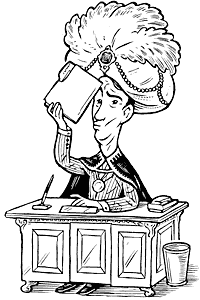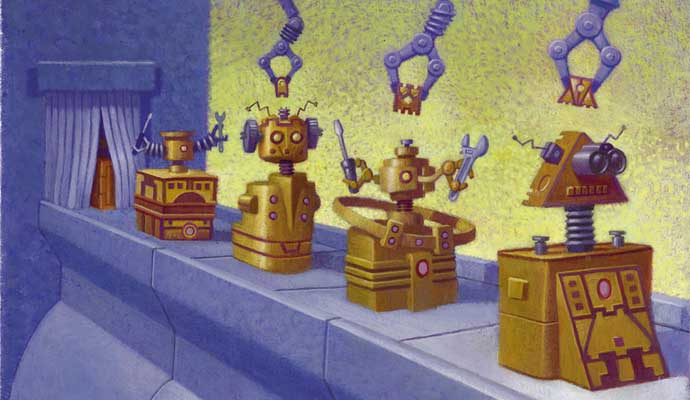The man who saw the future
As the pace of change in business accelerates, the legacy of Pierre Wack, the father of scenario planning, is more relevant than ever.
 |
|
Illustration by Lars Leetaru |
That observation is probably the most succinct description there is of the practice of scenario planning. Scenario planning — the use of alternative stories about the future, many with improbable and dramatic twists, to develop strategy — is one of the few management innovations to have actually been created in a corporate setting, amid the real-life battle for profits. Pierre Wack, who died in 1997, was the leader of the Royal Dutch/Shell Group of Companies’ elite London-based scenario team. With his colleagues and successors at Shell’s Group Planning department, he designed and refined this important business tool, in effect serving as the chief analyst of Shell’s version of Her Majesty’s Secret Service. Scenario planning alerted Shell’s managing directors (its committee of CEO equivalents) in advance about some of the most confounding events of their times: the 1973 energy crisis, the more severe price shock of 1979, the collapse of the oil market in 1986, the fall of the Soviet Union, the rise of Muslim radicalism, and the increasing pressure on companies to address environmental and social problems. The method has since become widely popular outside Shell, not just in corporations but in some governments. In South Africa, for example, scenario planning played a major role in the peaceful transition from a system of apartheid to a stable multiracial government.
Yet for all of that, and despite its reputation for prescience and panache, scenario planning has not always been influential within the companies that use it, including Shell itself. To be sure, the “energy crisis” scenarios, in particular, helped Shell prosper more than its rivals. Called the “Ugly Sister” by Forbes for its relatively weak financial position in the late 1960s, Shell moved to become one of two breakout leaders (Exxon was the other) of the industry. Even so, the company often seemed to ignore many of the warnings from its own scenarios. For example, the scenarios might have helped it avoid some extremely costly failed investments in the 1970s and 1980s, as well as the public relations and legal damage associated with its 1995 plan to dispose of the Brent Spar storage facility by sinking it in the North Sea.
Shell is hardly unique; most companies that create scenarios of potential risks and opportunities find it difficult to actually make effective real-world decisions based on the stories they imagine.
Pierre Wack understood this paradox as well as anyone. Today, his legacy is more relevant than ever: The political and economic uncertainties that Mr. Wack foresaw (he christened the future “the rapids” back in 1975) have become a fundamental part of business life. A clear sense of the future’s obscure challenges and opportunities is the most valuable asset an executive can have. To Mr. Wack, the ability for which managers are most celebrated — the ability to get things done — was only one part of their necessary skills. Equally important, and much harder to come by, was the ability to see ahead. The more aware the wolf pack is of the terrain in which it runs, the more effectively it hunts. What does it take to engender that awareness in managers, particularly in these shocking and skittish times?
Early in October 2002, I visited Shell Centre in London for an answer. Officially, I was there to attend a commemorative celebration of 30 years of scenario planning at Shell. The first great scenario event at Shell had been a 1972 report to the managing directors anticipating the impending energy crisis. With host Ged Davis, Shell’s vice president of global business environment and the company’s genial and erudite leader of scenario planning today, we met in a corporate banquet room. On the walls were brightly colored murals with the names of futures from years gone by, some of which never came to pass and others of which were counterintuitive but did come true: “Oil Tightrope,” “Greening of
Russia,” “Liberalisation,” “Business Class.” The room was filled with Group Planning members and alumni ranging in age from 30 to 80, along with about 30 outsiders who had used or explored scenarios in some noteworthy way.
During one breakout session, I joined a group of obstreperous firebrands (Shell’s Group Planning department has always employed some of these) on the subject of “life after scenarios.” They were keenly aware, of course, that scenarios have become a widespread consulting practice, popularized by such futurists and management writers as Peter Schwartz, Arie de Geus, Joseph Jaworski, Charles Hampden-Turner, and Kees van der Heijden — all former senior officials in Shell’s Group Planning department. There is also now a collegial network of scenario planners and consultants around the world; one Shell alumnus, Napier Collyns, was honored at the celebration for his role in fostering that network. (Mr. Collyns and Mr. Schwartz went from Shell to cofound Global Business Network, another central source of scenario practice.)
But Mr. Collyns pointed out the essential contradiction in scenario work: Shell’s original insights came from “years of deep research, rigorous analysis, ongoing conversations, and multiple iterations of the scenarios themselves” — all conducted by Shell’s mysterious and brilliant team. But over time, the method seems to have been watered down into just another three- or four-day workshop in which people feel like they’ve expanded their thinking away from the office, but still return to business as usual. Perhaps, some of the firebrands suggested, the golden age of scenarios is ending. Maybe some new methodology is needed to help companies see their own troubled futures as clearly as Shell saw the energy crisis in 1972.
I felt that if Pierre Wack were at the anniversary celebration himself, he might find the discussion beside the point. He had, after all, experienced the same sort of frustration throughout his career with scenarios, which began in the 1960s.
Thinking the Unthinkable
The seeds of scenario planning methodology were planted in the late 1940s, when the futurist Herman Kahn, then a young defense analyst at the Rand Corporation, started telling brief stories to describe the many possible ways that nuclear weapons technology might be used by hostile nations. (For this, Scientific American described Mr. Kahn as “thinking the unthinkable,” a characterization he embraced gleefully.) Near Rand’s Southern California offices, Mr. Kahn hung out with screenwriters and moviemakers — one of whom, Stanley Kubrick, used him as a model for Dr. Strangelove, and another of whom, Leo Rosten, suggested the name “scenarios” for these storytelling exercises.
But by the mid-1960s, Mr. Kahn’s methods had become a mechanistic smorgasbord approach, serving up dozens of possible forecasts (often generated with mainframe computers). The method would probably have died of sheer complexity, except that two individuals from Shell sought out Mr. Kahn. One was Mr. Wack, then head of planning at Shell Française (originally from Alsace-Lorraine, he pronounced his surname to rhyme with “Jacques”). The other was Ted Newland, a senior staff planner known for his incisive, unsentimental views of global politics. When Mr. Wack and Mr. Newland joined forces at Shell’s headquarters in 1971, they already shared two key insights. First, change in the Arab world was about to destroy the stability of the existing oil regime, which oil companies had dominated (and drawn a profit stream from) for 25 years. Second, everybody in the oil industry knew it, but nobody was prepared to do anything. With sponsorship from several far-seeing Shell managing directors, the two assembled a team to bring that awareness to the entire organization.
Scenario planning was just a starting point for them. Mr. Wack, who had studied some of the mystic traditions of India and Japan in depth, had been a student of the Sufi mystic G.I. Gurdjieff in the 1940s, and he had learned to cultivate what he called “remarkable people” around the world; this phrase in French means not so much gifted or eccentric people, but people with unconventional insights about the world around them. At that time, most oil executives believed that tensions in the Middle East would soon abate because Western-dominated stability would triumph; it always had before. Mr. Wack and Mr. Newland systematically examined every possible angle of the situation, with particular attention to the pressures faced by the ruling governments of Iran and Saudi Arabia. They concluded that it would take a miracle to avoid an energy crisis, and a set of keenly focused scenarios to make managers not just intellectually realize the danger, but prepare for it.
“People today could not possibly believe the degree of inward-lookingness that there was in the companies [of the 1960s],” Mr. van der Heijden told the 30th anniversary celebrants gathered in London last October. “Suddenly Pierre and Ted came in and showed us that you could open the window and look at the world.”
Shell Responds
During 1972 and early 1973, the Group Planners’ message percolated through the global Shell organization: The oil price could soar from its current $2 per barrel to an unimaginable price of as much as $10 per barrel. (Actually, by 1975, it would hit $13.) Despite resistance from some Shell managers, the organization began to put in place many of the commonsense, mundane frugalities that had been lost amid the frenetic growth of the 1950s and 1960s. This put Shell in an enviable position when the crisis did occur, and an even more enviable position during the Iranian revolution of 1979, when the oil price soared a second time, up to $37 per barrel. As the shock from that shift subsided, the industry entered a bubble. Through the early 1980s, oil traders assumed the price would keep rising; they kept bidding for oil futures and driving the price higher.
Once again, in the early 1980s, Shell’s planners offered a counterintuitive message: They said the bubble would collapse. The forces holding OPEC together would fragment, energy demand would finally slow down, and the industry would have to retrench. Mia de Kuijper, one of the young planners of that era, proposed that oil was about to become a commodity product. This was a shocking notion to many executives because it meant, as Ms. de Kuijper later noted, that “a trader in Rotterdam would have more to say about the price of oil than the managing directors.” Ted Newland actually stood before the Shell managing directors in 1982 and intoned a nursery rhyme to describe OPEC’s impending disarray: “Humpty Dumpty sat on a wall. Humpty Dumpty had a great fall.” As the price fell over the next three years, it set in motion an industry consolidation that eventually swallowed three of the major oil companies known as the “Seven Sisters.”
Mr. Wack and Mr. Newland left Shell in 1982. Mr. Wack began consulting for Anglo American, the South African mining corporation, on its efforts to globalize. One of his fascinating insights involved the effect of apartheid on the price of gold production. He said, “South Africans live with the feeling that they are blessed with a geological miracle: their gold and diamond deposits. But it is actually a human miracle: People work in horrible conditions for very low wages. ‘Be careful,’ I told them. ‘You are going to be the highest-cost producer, because this human miracle is not going to last.’ ”
To Anglo American executives, Mr. Wack seemed to be predicting the end of apartheid, and they wanted to hear more. So did their spouses; indeed, they wanted to know if there was a future for their children in South Africa, or whether they should emigrate. An Anglo American executive named Clem Sunter picked up the challenge, and, inspired by Pierre Wack, he suggested two scenarios for the country: A “low road” scenario in which the whites fought to hold on to apartheid, and a “high road” scenario in which they accepted the inevitability of a multiracial society and pushed for the kind of widespread economic growth that would allow such a society to thrive (in part by bringing South African business back into the flow of the international economy). Mr. Sunter’s 1987 book, The World and South Africa in the 1990s (Human & Rousseau Tafelberg Ltd.), became a bestseller in South Africa during the late 1980s and early 1990s, second only to Nelson Mandela’s autobiography Long Walk to Freedom. It is credited with helping South Africa’s white population see the value of a peaceful transition from apartheid.
The Gentle Art
By the time Mr. Wack left Shell, he had concluded that scenario planning, in itself, was not nearly effective enough at changing, as he put it, “the mental maps of managers.” The best way for me to explain this deficiency is to describe one of my own scenario projects, conducted for an Internet service provider at the height of the dot-com bubble.
We came up with four possible images of the future. Three represented glittering futures of easy success, and then there was the sad story called “Gruel,” in which the venture capital market for Internet entrepreneurs dried up. During our sessions, I tried but failed to coax the group to pay more attention to Gruel. Preparing for that future would have meant building some cash reserves, being more frugal, and focusing on short-term revenue streams. Had they done all that, they might still exist today. Had I paid better attention to changing their mental maps, I might have had the confidence to tell them not just that this worst-case scenario was plausible, but that it was predetermined. By not seeing the possibility of Gruel, my clients were helping to ensure that it would happen.
What, then, does it take to come up with the kind of scenario that makes people shed their natural defenses so they can understand and prepare for the futures that are inevitable, if only they could spot the factors that create them? Mr. Wack spent his last year with Shell traveling the world, trying to come up with an answer to this question. He returned with a single cryptic diagram labeled “the gentle art of reperceiving.” It showed a process involving not just study of the business environment (through scenarios), but a rigorous and intuitive examination of one’s own intent, of competitive advantage (à la Michael Porter), and of strategic options. But even Shell, which based a set of workshops on the Pierre Wack process, couldn’t make them stick.
It turns out that you can’t develop this kind of capability in a set of workshops — or even through an elite agency of analysts and internal consultants. If you truly want to create a “pack of wolves” attuned to the environment around them, then the people making decisions have to devote their careers to increasing their collective awareness of the outside world. Scenario planning, as Mr. Wack conducted it, provides precisely this kind of in-depth training over time. You research present key trends; you determine which are predictable and which are uncertain; you decide which uncertainties are most influential; you base some stories of the future on those uncertainties; you spend some time imaginatively playing out the implications of those stories; and then you use those implications to start all over again and develop a sense of the impending surprises that you cannot ignore.
Very, very occasionally, a company takes this way of using scenarios to heart. For instance, the South African energy company Sasol Ltd., working with a scenario practitioner named Louis van der Merwe, has used an elaborate year-long exercise to shift the entire culture of the company toward scenario thinking — in part by having managers throughout the company take part in writing and publishing their own highly polished scenario book. Only time will tell, of course, whether or not that translates into better results. Managers and executives already report themselves taking risks more confidently and seeing options more clearly, which is not usually the case after scenario exercises.
Successful companies typically have one or two people with the ability to see their environment clearly. Pierre Wack’s methodology, which he never fully articulated while he was alive, is a way of developing this aptitude throughout the organization. Companies that achieve this tend to remain out of public view for fear of being copied or outdone. (Sasol, for instance, is ruthlessly private about the content of its scenarios.)
If executives at many companies seem paralyzed or in retreat during this moment of exceptional business uncertainty, perhaps it’s not just the environment that’s gotten to them. Perhaps it’s that, while pursuing the numbers day after day, they haven’t been systematically training themselves to be like wolves at the front of the pack. They haven’t been training themselves to see as far as they can see. ![]()
Reprint No. 03103
| Authors
Art Kleiner, art@well.com is the “Culture & Change” columnist and a regular contributor of “The Creative Mind” profiles for strategy+business. He teaches at New York University’s Interactive Telecommunications Program. His Web site is www.well.com/user/art. Mr. Kleiner is the author of The Age of Heretics (Doubleday, 1996); his next book, Who Really Matters: The Core Group Theory of Power, Privilege, and Business Success, will be published by Doubleday Currency in August 2003.
|



